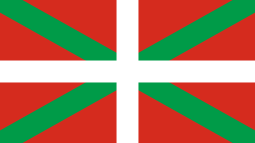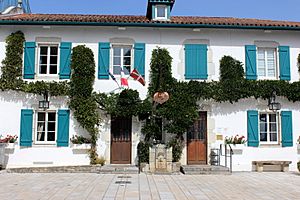Ikurriña facts for kids
 |
|
| Name | Ikurriña Ikurrina |
|---|---|
| Use | Civil and state flag |
| Proportion | 14:25 |
| Adopted | 19 October 1936 18 December 1978 |
| Design | A red field with the white central cross that extends to the edges of the flag superimposed on the green diagonal cross that extends to the corners of the flag. |
| Designed by | Luis Arana and Sabino Arana |
The ikurrina flag (in Basque) or ikurriña (Spanish spelling) is a special symbol for the Basque people. It is also the official flag of the Basque Country in Spain. This flag has a white cross over a green diagonal cross, all on a red background.
Contents
What the Ikurrina Name Means
The name ikurrina was created by Luis Arana and Sabino Arana. It comes from the Basque word ikur, which means 'mark' or 'sign'. In the Basque language, ikurrina can mean 'flag' in general. But it mostly refers to the flag of the Basque Country. The Euskaltzaindia (Royal Academy of the Basque Language) officially defines it this way.
Understanding the Flag's Design


The Ikurrina flag looks a bit like the Union Jack flag of the United Kingdom. It was designed by Luis Arana and Sabino Arana. They were the people who started the Basque Nationalist Party (EAJ-PNV). Many people see it as the unofficial national symbol of the entire Basque Country (Euskal Herria).
You can often see the Ikurrina in the French Basque Country. It is even part of the unofficial flag of Saint Pierre and Miquelon. This is a French overseas community in North America. Many French and Spanish Basque sailors settled there a long time ago. The Ikurrina is also the flag of the Basque Nationalist Party itself.
Colors and Their Meanings
Each color on the Ikurrina flag has a special meaning:
- The red background stands for the people of Biscay, a Basque province.
- The green diagonal cross might represent the Oak of Guernica. This tree is a symbol of the old laws of Biscay, called Fueros.
- The white cross on top represents God. It shows the strong Catholic faith of the Basque people.
Because of these meanings, red, white, and green have become the national colors of the Basque region.
History of the Ikurrina Flag
The Ikurrina was first designed in 1894. It was meant to represent the province of Biscay. The idea was to have one flag for each of the seven Basque provinces. There would also be one flag for the whole country. However, the Basque Nationalist Party mostly worked in Biscay. So, only the Biscayne flag became widely known.
It was first raised at the "Euzkeldun Batzokija" club. This club later became the EAJ-PNV party. The party officially adopted the flag in 1895. In 1933, they suggested it should be the flag for the entire Basque Country.
Official Recognition and Challenges
In 1936, the Basque Government officially adopted the Ikurrina. It became the flag of the Basque Autonomous Region. This happened after a socialist leader named Aznar suggested it. The flag was also used by the Basque Auxiliary Navy. This was a part of the Spanish Republican Navy during the Spanish Civil War. They operated in the Bay of Biscay.
After the Basque Government lost the war in 1938, General Franco's government banned the flag. But people in the Northern Basque Country (in France) continued to use it. For many years, the Ikurrina became a symbol of resistance. Secret groups, like ETA, would often place these banned flags in public places.
Return to Legality
In 1976, something special happened at a football match. Players from Athletic Club Bilbao and Real Sociedad worked together. They secretly brought out and displayed the illegal Basque flag at Atotxa Stadium. The authorities did not stop them. This event was a big step towards the flag becoming legal again.
The Basque flag was finally made legal again in 1977. This happened during Spain's move to democracy. Two years later, in 1979, the Basque Government officially adopted it. It became the flag of the Basque autonomous community. The Ikurrina is also used unofficially by some Basque groups in other provinces.
Gallery
-
The Basque left-wing nationalist party Herri Batasuna used a logo inspired by the Ikurriña.
-
Parade in Abadiño, Biscay.
-
Mauleon SA rugby team.
-
Castle of Mauléon-Licharre. 2017.
-
Saint-Jean-Pied-de-Port, 4 flags in the Town Hall.
See also
 In Spanish: Ikurriña para niños
In Spanish: Ikurriña para niños
- The arrano beltza ("black eagle") is another flag sometimes shown by Basque leftist nationalists along with the Ikurrina.
- The flag of Navarre is also used by some Basque groups. They see the old kingdom of Navarre as a step towards a future Basque state. You can sometimes see these three flags together at events.
- The modern flag of Saint Pierre et Miquelon (French North America) includes an Ikurrina. This shows its Basque history.
- Basque people
- Coat of arms of Basque Country (autonomous community)
- Politics and sports












